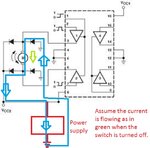sysysy
Member level 3
Hi,
I have few question wish to ask.
In my project, i understand the interfacing between my motor and l298 motor driver need 4 of the flyback diode.
From some information, the diode is for absorb the pulse energy when suddenly turn off the motor due to the inductor effect. In other word, mean the diode is to protect the driver or any nearest equipment.
My question is why the diode is connect in the way as below schematic example:
https://t1.gstatic.com/images?q=tbn:ANd9GcTS8QbeaDdV2C-B4v3KdtWDOC1MlImmJKOXR4WpnzK1xMLFk4HNMA
Anyone can explain how the diode can absorb energy in this schematic? why reversed bias in Vdd and forward bias in gnd? can anyone explain little bit about this design.
Secondly, i also look some information saying that some driver dun need flyback diode but some need. is this depends on how the transistor or mosfet connnect with the motor? why?
Hoping someone can share the knowledge if any.
Thanks alot.
Regards,
sysysy.
I have few question wish to ask.
In my project, i understand the interfacing between my motor and l298 motor driver need 4 of the flyback diode.
From some information, the diode is for absorb the pulse energy when suddenly turn off the motor due to the inductor effect. In other word, mean the diode is to protect the driver or any nearest equipment.
My question is why the diode is connect in the way as below schematic example:
https://t1.gstatic.com/images?q=tbn:ANd9GcTS8QbeaDdV2C-B4v3KdtWDOC1MlImmJKOXR4WpnzK1xMLFk4HNMA
Anyone can explain how the diode can absorb energy in this schematic? why reversed bias in Vdd and forward bias in gnd? can anyone explain little bit about this design.
Secondly, i also look some information saying that some driver dun need flyback diode but some need. is this depends on how the transistor or mosfet connnect with the motor? why?
Hoping someone can share the knowledge if any.
Thanks alot.
Regards,
sysysy.
